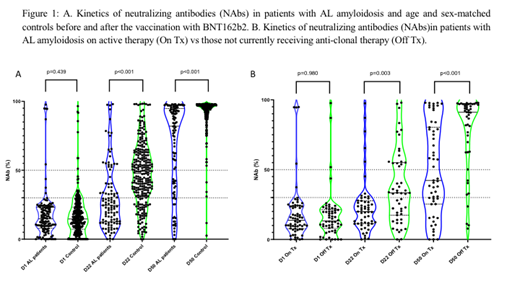Abstract
Patients with lymphoproliferative disorders are at high risk for severe COVID-19. For patients with AL amyloidosis, in which there is also critical organ involvement, this risk may be even higher. Vaccination against SARS-CoV-2 is the best strategy to avoid severe COVID-19, but response to vaccines may be compromised in patients with B-cell lymphoproliferative or plasma cell malignancies, as in AL amyloidosis. Although modest in size, the plasma cell clone in AL may cause immunosuppression while anticlonal therapies further compromise immune responses. To evaluate immunization efficacy, we measured the titers of neutralizing antibodies (NAbs) against SARS-CoV-2 after vaccination with BNT162b2 in patients with AL amyloidosis. As a control group we used volunteers, matched (ratio 1:2) for age and gender, who had no autoimmune or active malignant or infectious disease. Serum was separated within 4 hours from blood collection and stored at -80°C until the day of measurement on (A) day 1 (D1; before the first dose of BNT162b2) (B) day 22 (D22; before the 2nd dose) and (C) day 50 (D50; ie 30 days after the 2nd dose). NAbs against SARS-CoV-2 were measured using FDA approved methodology (cPass™ SARS-CoV-2 NAbs Detection Kit; GenScript, Piscataway, NJ, USA). According to the manufacturer of the assay, a titer ≥ 50% is considered a clinically relevant threshold for viral inhibition.
The study included 144 patients with AL amyloidosis, of which 120 had NAbs titers assessed on all time points and were included in the final analysis (53% males; median age: 66, IQR: 57-72 years) and 240 matched controls (53% males; median age: 66, IQR: 57-72 years). 66 (55%) AL patients were on active therapy, 17.5% were on daratumumab (DARA)-based therapy, 52 (43%) had discontinued therapy >3 months from the date of the first shot, 19% had prior exposure to DARA and 94 (78%) were in hematologic remission (CR or VGPR).
Prior to the 1st dose (D1), NAb titers were similar between patients and controls (median 14.9% (IQR 7.8-23.1%) vs 14% (IQR 6.8-22.9%), p=0.439); 6 AL patients had baseline NAbs >50%, of which 5 reported a history of COVID-19 infection.
On D22, there was a significant increase of NAbs titers both in controls and AL patients (both p<0.001); however, median NAb titer was 23.6% (IQR 12.4-37.7%) in AL patients vs 47.5% (IQR 32.1-62.7%) in controls (p<0.001) and 20.5% of AL patients vs 46.7% of controls (p<0.001) developed NAb titers ≥50%.
On D50, there was further increase in NAbs titers both in controls and AL patients (both p<0.001) and median NAb titer for AL patients was 83.1% (IQR 41.5-94.9%) vs 95.6% (IQR 91.7-97.2%) in controls (p<0.001); 71% of AL patients vs 98% of matched controls (p<0.001) developed NAb titers ≥50%.
Among AL patients, factors associated with NAb titers on D50 included age (p<0.001), lymphocyte counts (p<0.001), serum albumin (p<0.001) and amount of proteinuria at the time of vaccination (p=0.047), renal involvement (p=0.047), use of steroids (p<0.001), active treatment (p<0.001), treatment-free interval (p=0.001), remission status (CR/VGPR) (p=0.018). There was no significant association with gender (p=0.092), BMI (p=0.198), IgG (0.099), IgA (p=0.789) or IgM levels (p=0.687), liver (p=0.521) or heart involvement (p=0.141). Patients on therapy had lower NAb titers at D50 (median 50.1% (IQR 25.3-84.1%) vs 91.6% (IQR 74.5-96.5%) for those not on treatment, p<0.001), so that 51% had a D50 NAb titer ≥50% vs 87% of those not on therapy. Current DARA therapy (median 52.1% vs 46.4% without DARA, p=0.486) or prior exposure to DARA (92.1% vs 91.2%, p=0.966) were not associated with D50 NAb titers.
Generalized linear models were used for evaluation of multiple factors associated with D50 NAb titers: at least 3 months since the last dose of anticlonal therapy (p<0.001), lymphocyte counts (p=0.001) and serum albumin levels at the time of vaccination (p=0.020) were independent predictors of NAb titers on D50. When seroconversion was defined as a NAb titer ≥50% at D50, then >3 months of treatment-free interval (HR:7.75, p<0.001,) was the strongest factor associated with seconversion.
In conclusion, patients with AL amyloidosis have an attenuated response to vaccination with BNT162b2 especially among those on active therapy or with less than 3 months since the last dose of treatment. For such patients, an anamnestic dosing strategy could be considered, especially after completion of anticlonal therapy.
Kastritis: Genesis Pharma: Honoraria; Janssen: Consultancy, Honoraria, Research Funding; Takeda: Honoraria; Pfizer: Consultancy, Honoraria, Research Funding; Amgen: Consultancy, Honoraria, Research Funding. Terpos: Novartis: Honoraria; Janssen: Consultancy, Honoraria, Research Funding; Genesis: Consultancy, Honoraria, Research Funding; Celgene: Consultancy, Honoraria, Research Funding; BMS: Honoraria; Amgen: Consultancy, Honoraria, Research Funding; Takeda: Consultancy, Honoraria, Research Funding; Sanofi: Consultancy, Honoraria, Research Funding; GSK: Honoraria, Research Funding. Gavriatopoulou: Sanofi: Honoraria; GSK: Honoraria; Karyopharm: Honoraria; Takeda: Honoraria; Genesis: Honoraria; Janssen: Honoraria; Amgen: Honoraria. Dimopoulos: Amgen: Honoraria; BMS: Honoraria; Janssen: Honoraria; Takeda: Honoraria; BeiGene: Honoraria.


This feature is available to Subscribers Only
Sign In or Create an Account Close Modal